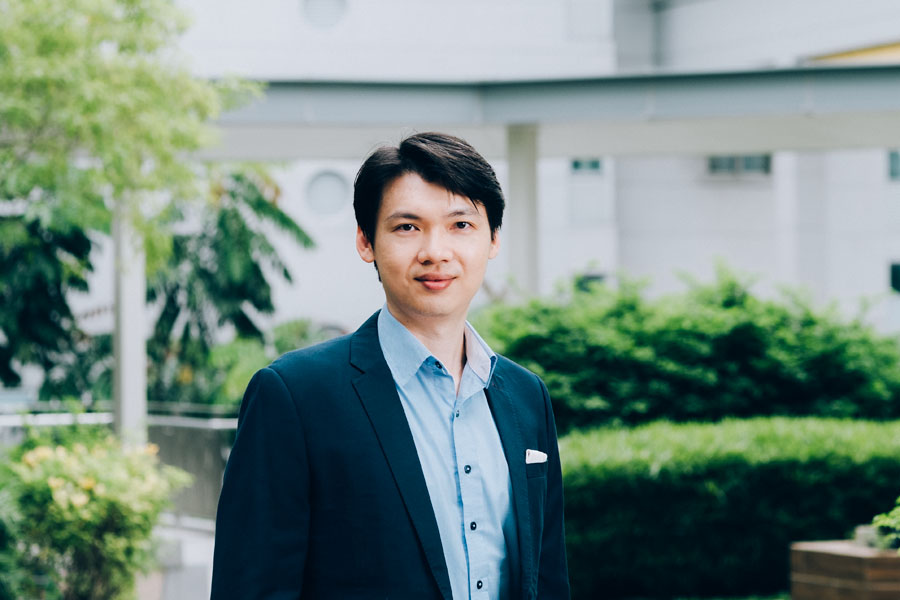Dr Benjamin C.K. Tee is Associate Professor in Materials Science and Engineering Department at the National University of Singapore.
He was awarded the National Research Foundation Fellowship in 2017. He obtained his PhD at Stanford University, and was a 2014 Singapore-Stanford Biodesign Global Innovation Postdoctoral Fellow. He won the MIT TR35 Innovator (Global) award in 2015 and listed as World Economic Forum’s Young Scientist of the year in 2019. His research team won the International Winner of the James Dyson Foundation Prize in 2021 for their work on healthcare sensors. This was the 1st time a Singapore team won as the international winner in the award’s 17-year history.
He leads the Sensors.AI Labs that research and translate technologies at the cutting edge of materials science, mechanics, electronics and biology. His current focus is on developing new skin-like electronic materials and systems that have tremendous potential to advance robotics and healthcare technologies in an increasingly Artificial Intelligence (AI) era. His inventions can help to tackle challenging needs in health, robotics and AI.
He has translated technologies for real-world impact through entrepreneurial pursuits. He has co-founded two medical technology companies Privi Medical and Hannah Life Technologies in Singapore. Privi Medical was successfully acquired in 2021 and Hannah Life Technologies grew rapidly and reached double-digit percentage monthly revenue growth across international markets such as the US, UK and Singapore within 12 months of product launch.
He has been featured by multiple top international news agencies including CNN International as one of their Tomorrow’s Hero series, by Channel News Asia International in the ASEAN’s Next Generation Leaders documentary and by BBC World Service Radio and National Geographic TV.
Research Interests
Professor Tee’s research focuses on exploiting novel materials and/or nano/micro-fabrication techniques to create novel flexible and stretchable electronic sensor devices. These devices can be used in a variety of applications from human-machine interfaces to biomedical uses.
Selected Publications:
- A Skin-Inspired Organic Digital Mechanoreceptor, B. C-K. Tee, A. Chortos, A. Berndt, et al., Science, 350, 313–316 (2015).
- Shape-Controlled, Self-Wrapped Carbon Nanotube Three-Dimensional Electronics, H. Wang, Y. Wang, B. C-K. Tee, K. Kim, J. Lopez, W. Cai, and Z. Bao, Advanced Science, 2, 1500103, (2015)
- Tunable Flexible Pressure Sensors using Microstructured Elastomer Geometries for Intuitive Electronics, B. C-K. Tee et al., Advanced Functional Materials 24, 5427–5434, (2014)
- Continuous Wireless Pressure Monitoring and Mapping with Ultra-Small Passive Sensors for Health Monitoring and Critical Care, Nature Communications, L. Chen, B. C-K. Tee, et al. 5, 5028, (2014)
- Flexible polymer transistors with high pressure sensitivity for application in electronic skin and health monitoring, G. Schwartz, B. C-K. Tee, et al., Nature Communications, 4, 1859, (2013)
- Solution coating of large-area organic semiconductor thin films with aligned single-crystalline domains, featured in Y. Diao, B. C-K. Tee, et al., Nature Materials, 12, 665–671, (2013)
- An electrically and mechanically self-healing composite with pressure- and flexion-sensitive properties for electronic skin applications, B. C-K. Tee, C. Wang, R. Allen, Z. Bao, Nature Nanotechnology, 7, 825–832, (2012)
- Transparent, Optical, Pressure-Sensitive Artificial Skin for Large-Area Stretchable Electronics, M. Ramuz, B. C-K. Tee, J. B.-H.Tok, Z. Bao, Advanced Materials, 24, 3223-3227, (2012)
- Skin-Like Sensors of Pressure and Strain Enabled by Transparent, Elastic Films of Carbon Nanotubes, D.J. Lipomi*, M. Vosgueritchian*, B. C-K. Tee* et al., Nature Nanotechnology, 1–6, (2011) (*equal contribution)
- SCB Mannsfeld, B. C-K Tee, et al., Highly sensitive flexible pressure sensors with micro-structured rubber dielectric layers, Nature Materials 9, 859–864, (2010) | Featured on Nature News and Views.


